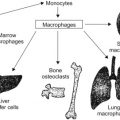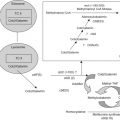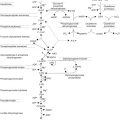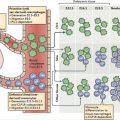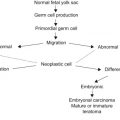Abstract
Tumors of the central nervous system (CNS) are the second most common group of cancers in childhood, accounting for 20% of all childhood malignancies, and affecting 35 per million children. A total of 60–70% of childhood CNS tumors arise from glial cells and tend not to metastasize outside the CNS. The relative frequency of specific CNS tumor types can be seen in Table 23.1.
Keywords
Central nervous system, primitive neuroectodermal, intracranial pressure, glioma, medulloblastoma, neurofibromatosis type 1
Epidemiology
Tumors of the central nervous system (CNS) are the second most common group of cancers in childhood, accounting for 20% of all childhood malignancies, and affecting 35 per million children. A total of 60–70% of childhood CNS tumors arise from glial cells and tend not to metastasize outside the CNS. The relative frequency of specific CNS tumor types can be seen in Table 23.1 .
| Location and histology | Frequency (%) |
|---|---|
| Supratentorial | 16 |
| Low-grade glioma | 3 |
| Ependymoma | 5 |
| High-grade glioma | 3 |
| Primitive neuroectodermal | 2 |
| Tumor (primitive neuroectodermal tumor) | |
| Other | |
| Sella/chiasm | |
| Craniopharyngioma | 6 |
| Optic nerve glioma | 5 |
| Total | 40 |
| Infratentorial | |
| Cerebellum | |
| Medulloblastoma | 20 |
| Astrocytoma | 18 |
| Ependymoma | 6 |
| Brain stem | |
| Glioma | 14 |
| Other | 2 |
| Total | 60 |
Pathology
Supratentorial Lesions
- 1.
Cerebral hemisphere: low- and high-grade glioma, ependymoma, meningioma, primitive neuroectodermal tumor (PNET).
- 2.
Sella or chiasm: craniopharyngioma, pituitary adenoma, germ cell tumors, optic nerve glioma.
- 3.
Pineal region: Pineoblastoma, pineocytoma, germ cell tumors, astrocytoma.
Infratentorial Lesions
- 1.
Posterior fossa: medulloblastoma, glioma (low more frequent than high-grade), ependymoma, meningioma.
- 2.
Brain stem tumors: low- and high-grade glioma, PNET.
Ventricular Lesions
- 1.
Choroid plexus papilloma, choroid plexus carcinoma, neurocytoma.
The most useful pathologic classification for brain tumors is based on embryonic derivation and histologic cell of origin. Tumors are further classified by grading the degree of malignancy within a particular tumor type. This grading is useful in astrocytoma and ependymoma. Criteria that are useful microscopically in grading the degree of malignancy include:
- •
Cellular pleomorphism.
- •
Mitotic index.
- •
Anaplasia and necrosis.
- •
MIB-1 index.
- •
Molecular Pathology of CNS Neoplasms
The majority of CNS neoplasms are sporadic. Only a small percentage is associated with inherited genetic disorders.
Chromosomal abnormalities have been identified in many pediatric brain tumors. These chromosomal abnormalities can be helpful in determining the pathologic classification of certain tumors. For example, a mutation or deletion of the tumor suppressor gene INI1 is often used to help distinguish atypical teratoid rhabdoid tumors from PNET or medulloblastoma. Discoveries regarding the molecular variation among tumors of the same pathologic classification have caused a major shift in the treatment of these tumors, as targeted therapies and unique approaches to these molecular subtypes are being explored.
Table 23.2 describes common cytogenetic abnormalities identified in brain tumors.
| Tumor | Chromosome | Disorder |
|---|---|---|
| PNET/MB | 5q21-22 | Turcot syndrome a |
| 9q22.3 | NBCCS | |
| 17p13.3 | ||
| 17q | ||
| Astrocytoma grades III–IV | 7p12 | |
| 17p13.1 | Li–Fraumeni syndrome | |
| 17q11.2 | NF-1 | |
| 3p21, 7p22 | Turcot syndrome a | |
| Subependymal giant cell tumor | 9q34 | Tuberous sclerosis |
| 16p13 | ||
| Meningioma/ependymoma | 22q12 | NF-2 |
| AT/RT | 22q11.2 | |
| Hemangioblastoma | 3p25 | von Hippel–Lindau |
a A rare and distinctive form of multiple intestinal polyposis associated with brain tumors. Autosomal-recessive inheritance caused by mutation in one of the mismatch repair genes MLH1 or chromosome 3p, MPS2 on chromosome 7p or the adenomatous polyposis gene on chromosome 5q.
Clinical Manifestations
Intracranial Tumors
Symptoms and signs are related to the location, size, and growth rate of tumor:
- •
Slow-growing tumors produce massive shifts of normal structures and may become quite large by the time they first become symptomatic.
- •
Rapidly growing tumors produce symptoms early and present when they are relatively small.
The most common presenting signs and symptoms of an intracranial neoplasm are increased intracranial pressure (ICP) and focal neurologic deficits.
If symptoms and signs of increased ICP precede the onset of localized neurologic dysfunction, a tumor of the ventricles or deep midline structures is most likely. If localizing signs (seizures, ataxia, visual field defects, cranial neuropathies, or corticospinal tract dysfunction) are predominant in the absence of increased ICP it is more probable that the tumor originates in parenchymal structures (cerebral hemispheres, brain stem, or cerebellum).
General Signs and Symptoms of Intracranial Tumors
- 1.
Headache: in young children headache can present as irritability; often worse in the morning, improving throughout the day.
- 2.
Vomiting.
- 3.
Disturbances of gait and balance.
- 4.
Hemiparesis.
- 5.
Cranial nerve abnormalities.
- 6.
Impaired vision.
- a.
Diplopia (sixth nerve palsy): in young children diplopia may present as frequent blinking or intermittent strabismus.
- b.
Papilledema from increased ICP may present as intermittent blurred vision.
- c.
Parinaud syndrome (failure of upward gaze and setting-sun sign, large pupils, and decreased constriction to light).
- a.
- 7.
Mental disturbances: somnolence, irritability, personality or behavioral change, or change in school performance.
- 8.
Seizures: usually focal.
- 9.
Endocrine abnormalities: midline supratentorial tumors may cause endocrine abnormalities due to effects on the hypothalamus or pituitary and visual field disturbances as a result of optic pathway involvement.
- 10.
Cranial enlargement in infants: characteristic of increased ICP.
- 11.
Diencephalic syndrome: seen in patients aged 6 months to 3 years with brain tumors who present with sudden failure to thrive and emaciation. The syndrome is caused by a hypothalamic tumor in the anterior portion of the hypothalamus or the anterior floor of the third ventricle.
Spinal Tumors
Spinal tumors of children may be found anywhere along the vertebral column. They cause symptoms by compression of the contents of the spinal canal. Localized back pain in a child or adolescent should raise suspicion of a spinal tumor, especially if the back pain is worse in the recumbent position and relieved when sitting up. The major signs and symptoms of spinal tumors are listed in Table 23.3 . Most spinal tumors have associated muscle weakness and the muscle group affected corresponds to the spinal level of the lesions.
| Back pain (in 50%, increased in supine position or with Valsalva maneuver) |
| Resistance to trunk flexion |
| Paraspinal muscle spasm |
| Spinal deformity (especially progressive scoliosis) |
| Gait disturbance |
| Weakness, flaccid or spastic |
| Reflex changes (especially decreased in arms and increased in legs) |
| Sensory impairment below level of tumor (30% of cases) |
| Decreased perspiration below level of tumor |
| Extensor plantar responses (Babinski signs) |
| Sphincter impairment (urinary or anal) |
| Midline closure defects of skin or vertebral arches |
| Nystagmus (with lesions of upper cervical cord) |
Spinal tumors can be divided into three distinct groups:
- •
Intramedullary : these tumors tend to be glial in origin and are usually gliomas or ependymomas.
- •
Extramedullary–intradural: these tumors are likely to be neurofibromas often associated with neurofibromatosis. If they arise in adolescent females, meningiomas are more likely.
- •
Extramedullary–extradural: these tumors are most often of mesenchymal origin and may be due to direct extension of a neuroblastoma through the intervertebral foramina or due to a lymphoma. Tumors of the vertebra may also encroach upon the spinal cord, leading to epidural compression of the cord and paraplegia (e.g., PNET or Langerhans cell histiocytosis occurring in a thoracic or cervical vertebral body).
Genetic Syndromes Associated with Pediatric Brain Tumors
There are a number of genetic syndromes associated with pediatric CNS tumors ( Table 23.4 ).
| Syndrome | Chromosome | Protein | Inheritance | Brain tumor |
|---|---|---|---|---|
| Neurofibromatosis -1 | 17q11.2 | Neurofibromin | Autosomal dominant | Optic glioma |
| Neurofibromatosis-2 | 22q12.2 | Merlin | Autosomal dominant | Acoustic neuroma |
| Tuberous sclerosis | 9q34 | Hamartin | Autosomal dominant | Subependymal giant cell astrocytomas |
| 16p13.3 | Tuberin | Autosomal dominant | ||
| Li–Fraumeni | 17p13.1 | Tp53 | Autosomal dominant | Choroid plexus carcinoma, also glioblastoma multiforme |
| VHL | 3p25.3 | VHL | Autosomal dominant | Hemangioblastoma |
| Turcot | 5q21-22 | APC | Autosomal dominant | Medulloblastoma |
| 3p21, 7p22 | Autosomal recessive | Glioblastoma multiforme | ||
| Gorlin | 9q22 | PTCH1 | Autosomal dominant | Medulloblastoma |
Neurofibromatosis Type 1
Neurofibromatosis type 1 (NF-1) is an autosomal-dominant disorder with a worldwide incidence of 1 in 2500–3000 individuals. There is a high incidence of de novo mutations due to the large size of the NF-1 gene, which is 350,000 base pairs in length. The disorder is caused by a mutation on chromosome 17q11.2, which encodes for the neurofibromin protein, a negative regulator of Ras. Individuals with the condition are susceptible to the development of benign and malignant tumors. Other than neurofibromas, the most common tumors associated with this disorder are optic pathway gliomas. NF-1 is characterized by extreme clinical variability, even within a single family. Diagnosis is made when a patient exhibits two of the following seven criteria: six or more café-au-lait spots (>5 mm in prepubertal, >15 mm in postpubertal), two or more neurofibromas or one plexiform neurofibroma, axillary/inguinal freckling, optic pathway glioma, Lisch nodules, osseous lesions (kyphoscoliosis, sphenoid dysplasia, thinning of long bone cortex), and a first-degree relative with NF-1 by criteria.
Neurofibromatosis Type 2
Neurofibromatosis type 2 (NF-2) is an autosomal-dominant disorder caused by a mutation in the merlin gene located on chromosome 22q12.2. The syndrome is characterized by bilateral acoustic neuromas, meningiomas of the brain, spinal cord ependymoma, and schwannomas of the dorsal roots of the spinal cord.
Li–Fraumeni Syndrome
Li–Fraumeni syndrome is an autosomal-dominant disorder characterized by the early onset of tumors, multiple tumors within an individual, and multiple affected family members. The syndrome is caused by a mutation in the p53 gene located on chromosome 17p13.1. A variety of tumor types are seen throughout families affected with this disorder, most commonly sarcomas, breast cancer, leukemia, brain tumors, and adrenocortical carcinoma. In pediatric patients choroid plexus carcinoma has been found to have a strong association with Li–Fraumeni. Glioblastoma multiforme is also a CNS tumor frequently seen in children with this disorder.
Von Hippel–Lindau
von Hippel–Lindau disease is a dominantly inherited familial cancer syndrome caused by a heterozygous mutation in the VHL gene found on chromosome 3p25.3. Affected patients are predisposed to a variety of malignant and benign neoplasms. The most frequent tumors seen are retinal, cerebellar, and spinal hemangioblastomas. Other tumors commonly seen in the condition are renal cell carcinoma, pheochromocytoma, and pancreatic tumors.
Tuberous Sclerosis
Tuberous sclerosis complex is an autosomal-dominant disorder caused by a mutation in either the TSC1 gene on chromosome 9q34 or the TSC2 gene on chromosome 16p13.3. Either of these mutations results in an overexpression of the mTOR complex 1. The syndrome is characterized by hamartomas in multiple organ systems including the brain, skin, heart, and kidneys. Patients are predisposed to developing subependymal giant cell astrocytomas. These tumors have been found to respond well to the mTOR inhibitor everolimus. Additional CNS manifestations include the formation of cortical tubers and learning difficulties. Skin findings include shagreen patches, ash leaf spots, and facial angiofibromas. Other tumors associated with the syndrome include angiomyolipomas of the kidney and rhabdomyomas of the heart.
Turcot Syndrome
Turcot syndrome is a disorder characterized by colorectal polyposis and primary CNS tumors. There are thought to be two distinct groups of patients with Turcot syndrome. One group of patients has an autosomal-recessive pattern with early onset of malignant gliomas and colorectal adenomas. These patients typically have mutations in DNA mismatch repair genes. The second group of patients is those with familial adenomatous polyposis who have autosomal-dominant inheritance of mutations in the APC gene. The brain tumor commonly associated with this group is medulloblastoma.
Gorlin Syndrome
Gorlin syndrome is an autosomal-dominant disorder most commonly involving a mutation in the PTCH1 gene on chromosome 9q22. The disorder is characterized by the development of both basal cell carcinomas and medulloblastomas. Other clinical findings include odontogenic keratocysts, abnormal facies, intracranial calcifications, and rib, vertebrae, and other skeletal abnormalities.
Diagnostic Evaluation
Computed Tomography
The computed tomography (CT) scan is an important procedure in the detection of CNS malignancies. Scans performed both with and without iodinated contrast agents detect 95% of brain tumors. However, tumors of the posterior fossa, which are common in children, are better evaluated with magnetic resonance imaging (MRI). CT scans should be performed using thin sections (usually 5 mm). Sedation is often necessary to avoid motion artifacts. CT is more useful than MRI in:
- •
Evaluating bony lesions.
- •
Detection of calcification in tumor.
- •
Investigating unstable patients because of the shorter imaging time.
Magnetic Resonance Imaging
MRI provides the following additional advantages:
- •
No ionizing radiation exposure (especially important in multiple follow-up examinations).
- •
Greater sensitivity in detection of brain tumors, especially in the temporal lobe and posterior fossa (these lesions are obscured by bony artifact on CT).
- •
Ability to directly image in multiple planes (multiplanar), which is of value to neurosurgical planning (CT is usually only in axial planes, though reconstructions may be performed).
- •
Ability to apply different pulse sequences which is useful in depicting anatomy (T1-weighted images) and pathology (T2-weighted images).
- •
Ability to map motor areas with functional MRI.
MRI specificity is enhanced with the contrast agent gadolinium diethylenetriaminepentaacetic acid dimeglumine (Gd-DTPA), which should be used in the evaluation of childhood CNS tumors and has the following advantages:
- •
Highlights areas of blood–brain barrier breakdown that occur in tumors.
- •
Useful in identifying areas of tumor within an area of surrounding edema.
- •
Improves the delineation of cystic from solid tumor elements.
- •
Helps to differentiate residual tumor from gliosis (scarring).
The major difficulty with MRI in infants and children is the long time required to complete imaging and for this reason adequate sedation is required.
Magnetic Resonance Angiography
Magnetic resonance angiography has been utilized in the preoperative evaluation of the normal anatomic vasculature (e.g., dural sinus occlusion) but has not been particularly useful in the assessment of tumor vascularity.
Magnetic Resonance Spectroscopy
Magnetic resonance spectroscopy may be helpful in both diagnosing pediatric brain tumors and during follow-up investigations. This technique has been shown to be able to distinguish between malignant tumors and areas of necrosis by comparing creatine/choline ratios with n-acetyl aspartate/choline ratios. This technique, in combination with tumor characteristics as identified by MRI, tumor site, and other patient characteristics, may be able to more accurately predict the tumor type preoperatively. In addition, it may be helpful in identifying postoperative residual tumor from postoperative changes.
Positron Emission Tomography
Positron emission tomography (PET) is a potentially useful technique for evaluating CNS tumors. The fluorine-18-labeled analog of 2-deoxyglucose is used to image the metabolic differences between normal and malignant cells. Astrocytomas and oligodendrogliomas are generally hypometabolic, whereas anaplastic astrocytomas and glioblastoma multiforme are hypermetabolic.
PET is useful to determine:
- •
Degree of malignancy of a tumor.
- •
Prognosis of brain tumor patients.
- •
Appropriate biopsy site in patients with multiple lesions, large homogeneous and heterogeneous lesions.
- •
Recurrent tumor from necrosis, scar, and edema in patients who have undergone radiation therapy and chemotherapy.
- •
Recurrent tumor from postsurgical change.
The utility of recently developed PET-MRI scanning requires evaluation, though preliminary data demonstrate utility in astrocytomas.
Evaluation of the Spinal Cord
MRI and Gd-DTPA has replaced myelography in the evaluation of meningeal spread of brain tumors in the spinal column and delineating spinal cord tumors.
Cerebrospinal Fluid Examination
The cerebrospinal fluid (CSF) should have the following studies performed:
- •
Cell count with cytocentrifuge slide examination for cytology of tumor cells.
- •
Glucose and protein content.
- •
CSF α-fetoprotein (AFP).
- •
CSF human chorionic gonadotropin (β-hCG).
Polyamine assays in the CSF are of value in the evaluation of tumors that are in close proximity to the circulating CSF (medulloblastoma, ependymoma, brain stem glioma). The assay is not useful in glioblastoma multiforme and not predictive in astrocytomas. AFP and β-hCG of the CSF may be elevated in CNS germ cell tumors.
Bone Marrow Aspiration and Bone Scan
These studies are indicated in medulloblastoma and high-grade ependymomas with evidence of cytopenias on the blood count because a small percentage of these patients have systemic metastases at the time of diagnosis.
Treatment
Surgery
The purpose of neurosurgical intervention is threefold.
- 1.
To provide a tissue biopsy for purposes of histopathology and cytogenetics.
- 2.
To attain maximum tumor removal with the fewest neurologic sequelae.
- 3.
To relieve associated increased ICP due to CSF obstruction.
Use of preoperative dexamethasone can significantly decrease peritumoral edema, thus decreasing focal symptoms and often eliminating the need for emergency surgery. For patients with increased hydrocephalus that is moderate to severe, endoscopic or standard ventriculostomy can decrease ICP. Tumor resection is safer when performed 1–2 days following reduction in edema and ICP by these means.
Technical advances in neurosurgery that have improved the success of surgery include ultrasonic aspirators; image guidance (allows three-dimensional (3D) mapping of tumor); functional mapping and electrocorticography, which allow pre- and intraoperative differentiation of normal and tumor tissue; and neuroendoscopy. Intraoperative MRI scanning is useful in limited circumstances, when visualization by the neurosurgeon is compromised. Stereotactic biopsies allow biopsy of deep-seated midline tumors. The ideal goal is a gross-total resection of tumor (likely leaving microscopic residual) as removal of a margin of normal tissue would cause devastating neurologic sequelae.
Radiotherapy
Most patients with high-grade brain tumors require radiotherapy to achieve local control of microscopic or macroscopic residual. Radiation therapy for intracranial tumors consists of external beam irradiation using conventional fields or 3D-conformal radiotherapy. The latter decreases radiation to normal brain tissue by up to 30%.
Intensity-modulated radiation therapy (IMRT) uses more complex computerized planning and intensity modulation of the radiation to further decrease radiation to normal tissue under certain circumstances. Proton beam radiation virtually eliminates exit dose (the radiation dose that passes through the tumor and impacts normal tissues beyond), sparing some tissue from unwanted radiation.
It is particularly useful in tumor adjacent to sensitive areas such as the pituitary gland and spinal cord. Proton beam radiation is only available at relatively few centers nationwide.
The wider use of ionizing radiation in pediatric brain tumors has resulted in improved long-term survival. However, the significant long-term effects on cognition and growth, especially in patients requiring craniospinal irradiation (e.g., PNET) can be devastating.
The total dose of radiotherapy depends on:
- •
Tumor type (which also influences volume of treatment).
- •
Age of the child.
- •
Volume of the brain or spinal cord to be treated.
Current efforts seek to decrease radiation by conforming better to the tumor and by using chemotherapy in addition. Children 3 years of age are most drastically affected. In this group newer strategies that avoid or delay radiation therapy, by initial treatment with chemotherapy, have promising preliminary results. In medulloblastoma therapy, this approach allows up to 50% cure without ionizing radiation.
Brachytherapy, stereotactic radiosurgery, and fractionated stereotactic radiosurgery are alternatives to conventional radiation therapy presently under continuing study and may prove useful in relapsed patients.
Chemotherapy
Chemotherapy plays an important role in the management of recurrent disease and in many newly diagnosed patients.
Two anatomic features of the CNS make it unique with respect to the delivery of chemotherapeutic agents.
- 1.
The tight junction of the endothelial cells of the cerebral capillaries—the blood–brain barrier.
- 2.
The ventricular and subarachnoid CSF.
The blood–brain barrier inhibits the equilibration of large polar lipid-insoluble compounds between the blood and brain tissue, while small nonpolar lipid-soluble drugs rapidly equilibrate across the blood–brain barrier. The blood–brain barrier is probably not crucial in determining the efficacy of a particular chemotherapeutic agent, since in many brain tumors the normal blood–brain barrier is impaired. Factors such as tumor heterogeneity, cell kinetics and drug administration, distribution and excretion play a more significant role in determining the chemotherapeutic sensitivity of a particular tumor than the blood–brain barrier. Tumors with a low mitotic index and small growth fraction are less sensitive to chemotherapy; tumors with a high mitotic index and larger growth fraction are more sensitive to chemotherapy.
The CSF circulates over a large surface area of the brain and provides an alternate route of drug delivery; it can function as a reservoir for intrathecal administration or as a sink after systemic administration of chemotherapeutic agents. The rationale of instillation of chemotherapy into the CSF compartment is that significantly higher drug concentrations can be attained in the CSF and surrounding brain tissue. This mode of administration is most applicable in cases of meningeal spread or in those tumors in which the risk of spread through the CSF is high.
Adjuvant chemotherapy is used in select primary brain tumors in addition to recurrent disease. Tables 23.5, 23.6, 23.9, 23.10 and 23.12 list chemotherapy regimens commonly employed in brain tumors. In certain cases chemotherapy allows for decreased radiation doses with equal or improved cure rates. In others adjuvant chemotherapy improves outcome with standard radiation therapy. Trials of new agents, combinations of agents, and standard drugs as radio-sensitizing agents are ongoing.

